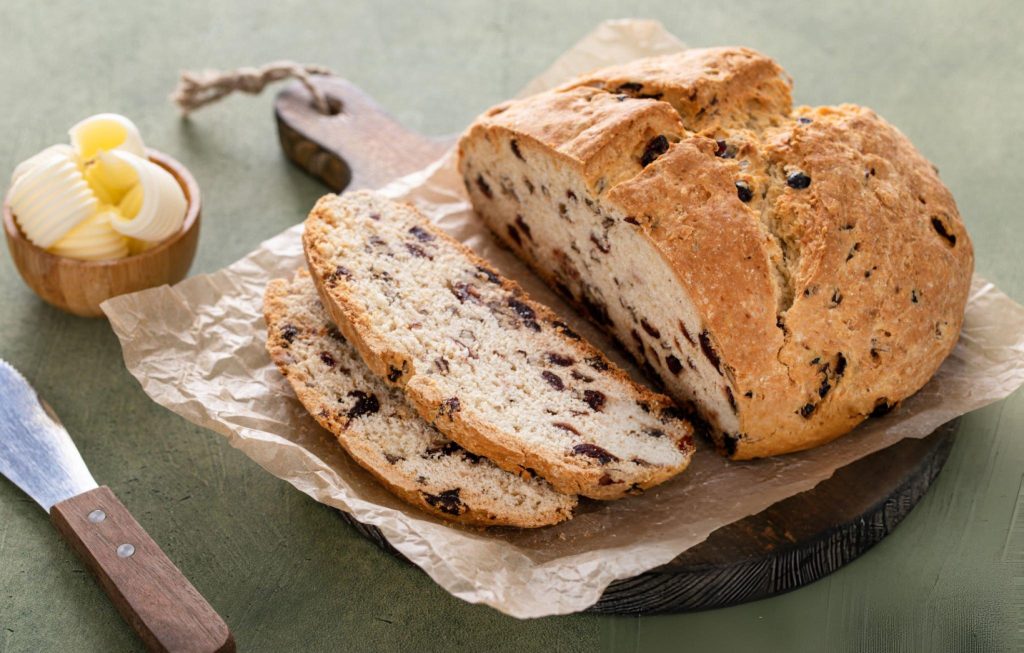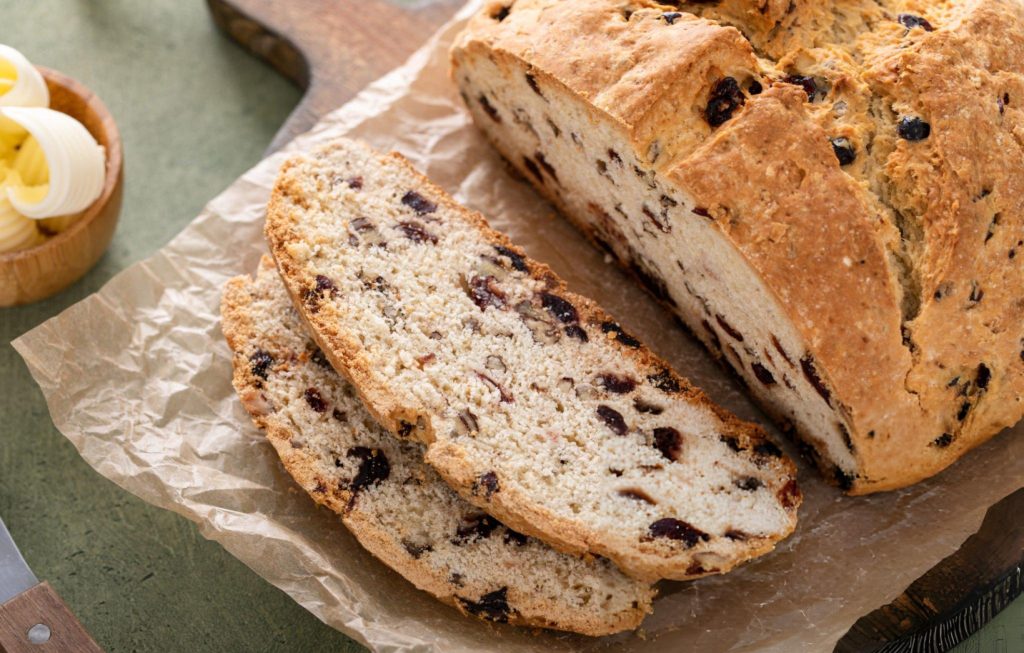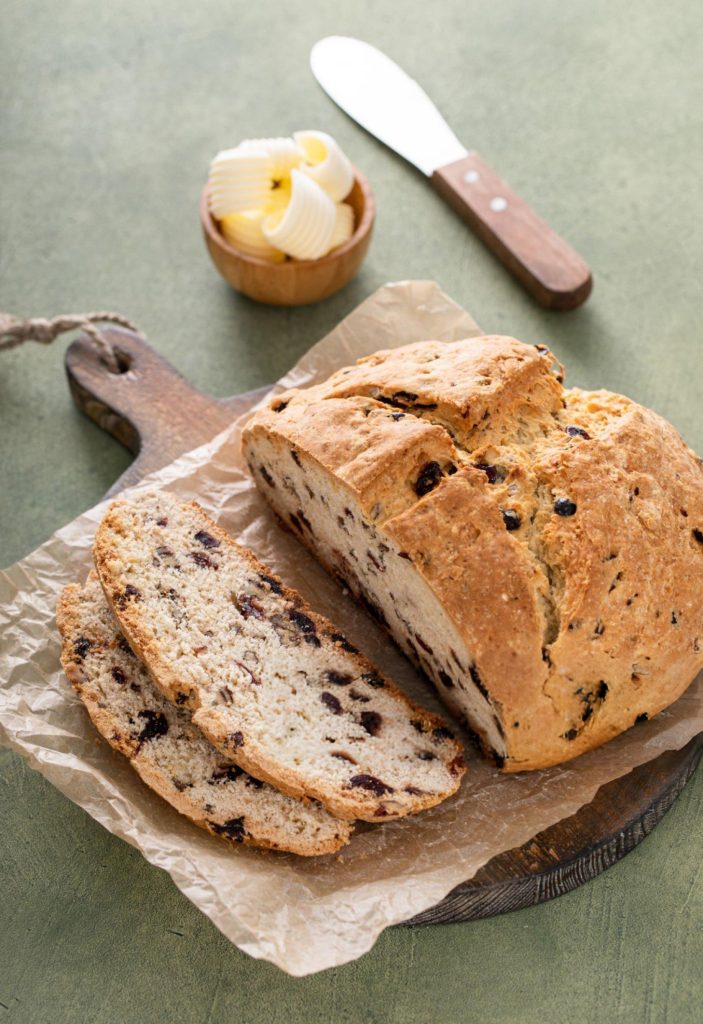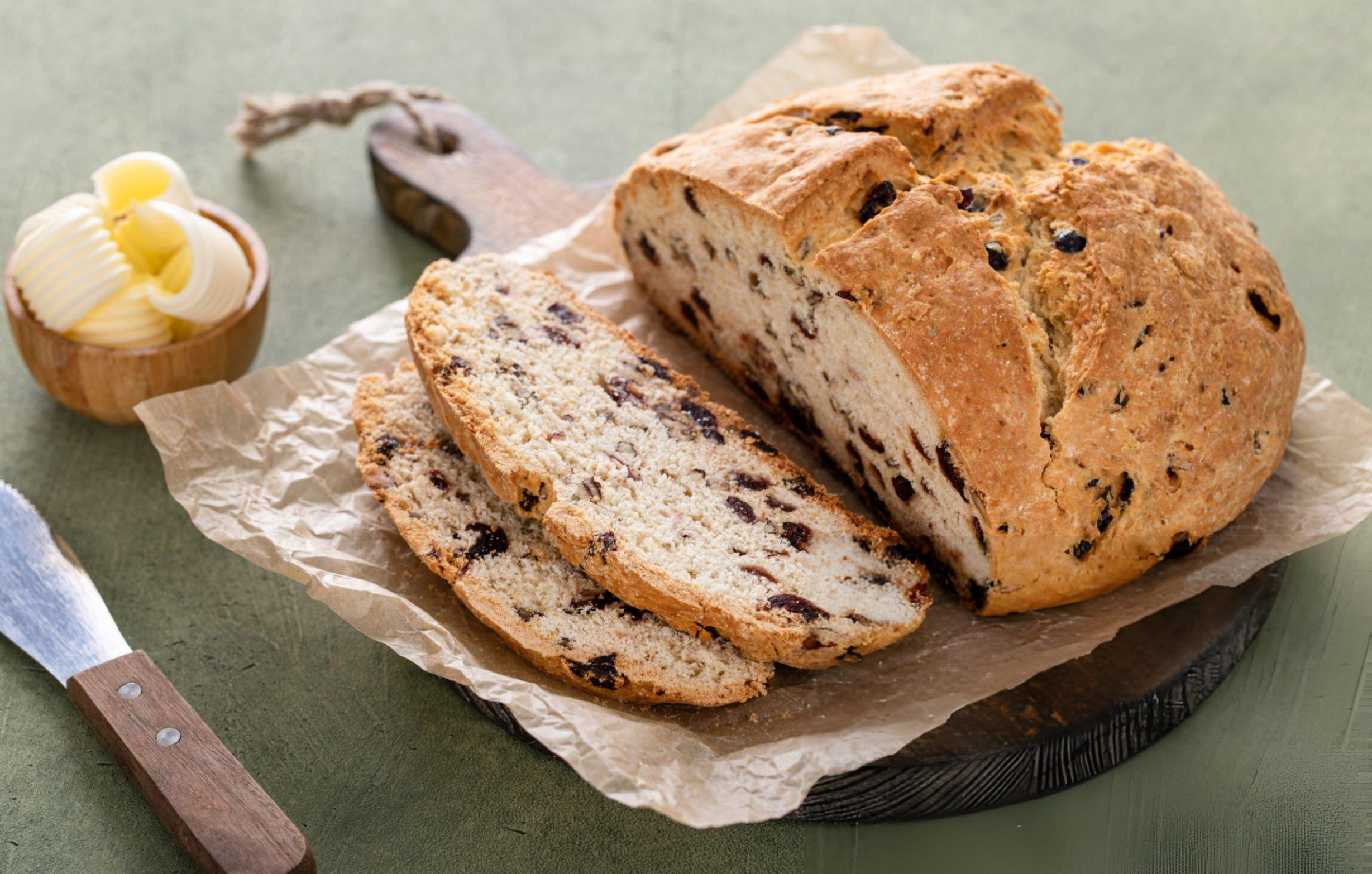Irish Soda Bread Recipe
Irish Soda Bread is a time-honored staple, celebrated for its simplicity and robust flavor. This rustic bread requires no yeast, relying instead on baking soda for leavening, making it a quick and accessible option for bakers of all levels. With its crisp crust and tender crumb, Irish Soda Bread is as versatile as it is delicious, whether served with a hearty stew or simply enjoyed with butter and jam.

Ingredients Overview
The ingredients for Irish Soda Bread are straightforward yet crucial in achieving the desired texture and flavor. The all-purpose flour forms the foundation, giving the bread its structure. Granulated sugar adds a subtle sweetness that balances the savory notes of the sea salt. Baking soda acts as the leavening agent, reacting with the acidity of the buttermilk or kefir to create a rise.
Cold unsalted butter is worked into the dry ingredients, creating a crumbly texture that ensures the bread remains tender. The cold buttermilk or kefir not only contributes to the bread’s moistness but also interacts with the baking soda to produce a light, airy crumb. A large cold egg is incorporated for richness and binding.
Optional ingredients like raisins or dried cranberries introduce bursts of sweetness and tartness, adding complexity to the bread’s flavor profile. These can be omitted or substituted based on personal preference, allowing the recipe to be customized to your liking.
Recipe Tips
Importance of using cold ingredients for the best texture:
Cold butter, buttermilk, and egg are essential for achieving the perfect texture in Irish Soda Bread. The cold butter creates small pockets of fat within the dough, which, when baked, melt to produce a tender crumb. Keeping the buttermilk and egg cold helps maintain the dough’s consistency, ensuring a light and fluffy interior.
Tips for handling and shaping the dough without overmixing:
Overmixing can lead to a tough loaf. Mix the ingredients just until the dough comes together, leaving it slightly shaggy. When shaping the dough, use floured hands and work it gently to avoid overworking the gluten.
How to properly score the bread for an even rise:
Scoring the top of the loaf with a deep “X” allows the bread to expand evenly as it bakes. This traditional technique also gives the bread its characteristic look.
Alternative mix-ins or variations for a personal touch:
Consider adding different dried fruits, nuts, or seeds to customize your Irish Soda Bread. A handful of oats sprinkled on top before baking can add a delightful texture and visual appeal.
Step-by-Step Preparation
Start by preheating your oven to 375˚F. Grease a 10-inch cast-iron skillet with cold butter, ensuring the entire surface is coated. This step is vital for achieving the bread’s signature crisp crust.
In a large mixing bowl, whisk together the flour, sugar, sea salt, and baking soda until well combined. This dry mixture must be evenly distributed to ensure the bread rises uniformly.
Cut the cold butter into small cubes and add it to the flour mixture. Using your fingers, gently work the butter into the flour until it resembles coarse crumbs. The goal is to incorporate the butter without melting it, maintaining those crucial fat pockets that will create a tender crumb.
If you’re including raisins or dried cranberries, now is the time to fold them in, breaking up any clumps to ensure even distribution.
In a separate measuring cup, whisk together the cold buttermilk and egg until fully combined. Pour this wet mixture into the dry ingredients, creating a well in the center. Using a wooden spoon, mix just until the dough starts to come together. It’s essential to stop mixing as soon as the dough is barely moistened; this will prevent overworking, which can lead to a dense, tough loaf.
Transfer the dough onto a floured surface. With floured hands, shape it into a rough, round loaf. The dough should be slightly sticky and shaggy in appearance. If it’s too sticky to handle, lightly dust it with more flour.

Baking Instructions
Place the shaped dough into the prepared skillet. Use a sharp knife to score a deep “X” across the top of the loaf. This scoring is not just for aesthetics; it helps the bread bake evenly and allows steam to escape, resulting in a better texture.
Position the skillet in the center of your preheated oven and bake for 50-55 minutes. The bread is done when it sounds hollow when tapped on the bottom. This hollow sound indicates that the interior is fully baked, with no doughy spots remaining.
Once baked, transfer the bread to a wire rack to cool completely. This cooling process allows the bread to set, making it easier to slice and enhancing its flavor.
What to Serve With This Recipe
Irish Soda Bread pairs beautifully with a variety of dishes. For a traditional Irish meal, serve it alongside hearty stews or soups, where the bread’s dense texture can soak up the rich broths.
For a simple yet satisfying breakfast, toast slices of Irish Soda Bread and slather them with butter, jam, or honey. The bread’s mild sweetness also makes it an excellent companion for savory spreads like cheese or smoked salmon.
Whether enjoyed as a side for dinner or as a base for a sandwich, Irish Soda Bread’s versatility makes it a perfect addition to any meal. Consider serving it with corned beef, cabbage, or even a robust Irish cheddar for an authentic experience.
Frequently Asked Questions
Can I make this recipe without a cast-iron skillet?
Yes, if you don’t have a cast-iron skillet, you can use a baking sheet or any oven-safe dish. The crust may not be as crisp, but the bread will still be delicious.
What can I use if I don’t have buttermilk?
If you don’t have buttermilk, you can make a substitute by adding a tablespoon of vinegar or lemon juice to a cup of milk. Let it sit for a few minutes to thicken before using.
How do I store Irish Soda Bread, and can it be frozen?
Irish Soda Bread is best enjoyed fresh but can be stored at room temperature for up to two days. To freeze, wrap it tightly in plastic wrap and place it in a freezer bag. It will keep for up to three months. Thaw at room temperature or reheat in the oven.
How can I add more flavor or texture to this bread?
You can experiment with different add-ins like caraway seeds, orange zest, or chopped nuts to enhance the flavor. For a richer texture, try using a combination of white and whole wheat flour.
Storage and Shelf Life
To keep your Irish Soda Bread fresh, store it in an airtight container at room temperature for up to two days. If you prefer to keep it longer, refrigeration is an option, though it may cause the bread to dry out slightly.
To reheat and refresh the bread, wrap it in aluminum foil and place it in a preheated 350˚F oven for about 10 minutes. This will restore some of the bread’s original texture and warmth.
For those looking to plan ahead, freezing is an excellent option. Once the bread has cooled completely, wrap it tightly in plastic wrap, followed by a layer of aluminum foil. Place it in a freezer bag and store it for up to three months. When ready to enjoy, thaw the bread at room temperature, or reheat it in the oven for a freshly baked feel.
Troubleshooting Common Issues
If your Irish Soda Bread turns out too dense, it may be due to overmixing the dough. The key to a light loaf is to mix the ingredients just until combined, leaving the dough slightly shaggy.
A tough crust or undercooked interior can result from incorrect oven temperature or baking time. Always preheat your oven and check the bread’s doneness by tapping on the bottom; it should sound hollow.
If the dough is too sticky to handle, resist the temptation to add too much flour, as this can make the bread dry. Instead, dust your hands and work surface lightly with flour, and handle the dough gently.
Irish Soda Bread is a delightful addition to any meal, offering a taste of tradition with the ease of modern baking. Its simplicity and versatility make it a go-to recipe for both novice and experienced bakers. Whether you enjoy it plain or with added flavors, this bread is sure to become a favorite in your kitchen. Don’t hesitate to experiment with variations and savor the comforting aroma of freshly baked bread filling your home.

Ingredients
1 tsp baking soda
1 tsp sea salt
1/4 cup granulated sugar
4 cups all-purpose flour, plus an additional 1/4 cup for dusting
6 Tbsp cold unsalted butter, with an extra 1/2 Tbsp for greasing the pan
1 3/4 cups cold lowfat buttermilk or kefir
1 large cold egg
1 cup raisins or dried cranberries (optional)
Instructions
Begin by preheating your oven to 375˚F. Grease a 10-inch cast-iron skillet generously with 1/2 Tbsp of butter to ensure the bread doesn’t stick.
In a spacious mixing bowl, combine the flour, sugar, salt, and baking soda, whisking them together until evenly distributed. Cut the cold butter into small pieces, then use your fingers to incorporate it into the dry ingredients until the mixture resembles coarse crumbs. If you’re using raisins or dried cranberries, stir them in now, making sure to separate any clumps.
Create a well in the center of the mixture. In a large measuring cup, whisk together the buttermilk and egg until fully combined. Pour this into the well of the flour mixture. Using a wooden spoon, gently mix until the dough is just barely moistened and starts to come together—it’s crucial not to overwork the dough.
Turn the dough out onto a floured surface. With floured hands, shape it into a rough, round loaf. The dough should be shaggy and slightly sticky; if it’s too sticky to handle, lightly dust with more flour. Be careful not to overmix, as this will result in a tougher bread.
Place the formed dough into the prepared skillet. Use a sharp knife to score a deep “X” across the top of the loaf. Bake in the preheated oven for 50-55 minutes, positioning the skillet in the center of the oven. The bread is done when it sounds hollow when tapped on the bottom.
Transfer the loaf to a wire rack to cool completely. This bread is best enjoyed within two days of baking. Store any leftovers in the refrigerator, where they will keep for up to a week.

Irish Soda Bread Recipe
Ingredients
- 1 tsp baking soda
- 1 tsp sea salt
- 1/4 cup granulated sugar
- 4 cups all-purpose flour plus an additional 1/4 cup for dusting
- 6 Tbsp cold unsalted butter with an extra 1/2 Tbsp for greasing the pan
- 1 3/4 cups cold lowfat buttermilk or kefir
- 1 large cold egg
- 1 cup raisins or dried cranberries optional
Instructions
- Begin by preheating your oven to 375˚F. Grease a 10-inch cast-iron skillet generously with 1/2 Tbsp of butter to ensure the bread doesn’t stick.
- In a spacious mixing bowl, combine the flour, sugar, salt, and baking soda, whisking them together until evenly distributed. Cut the cold butter into small pieces, then use your fingers to incorporate it into the dry ingredients until the mixture resembles coarse crumbs. If you’re using raisins or dried cranberries, stir them in now, making sure to separate any clumps.
- Create a well in the center of the mixture. In a large measuring cup, whisk together the buttermilk and egg until fully combined. Pour this into the well of the flour mixture. Using a wooden spoon, gently mix until the dough is just barely moistened and starts to come together—it’s crucial not to overwork the dough.
- Turn the dough out onto a floured surface. With floured hands, shape it into a rough, round loaf. The dough should be shaggy and slightly sticky; if it’s too sticky to handle, lightly dust with more flour. Be careful not to overmix, as this will result in a tougher bread.
- Place the formed dough into the prepared skillet. Use a sharp knife to score a deep “X” across the top of the loaf. Bake in the preheated oven for 50-55 minutes, positioning the skillet in the center of the oven. The bread is done when it sounds hollow when tapped on the bottom.
- Transfer the loaf to a wire rack to cool completely. This bread is best enjoyed within two days of baking. Store any leftovers in the refrigerator, where they will keep for up to a week.

